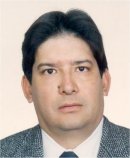|
Plenary
Lecture
Face Recognition Using Frequency Domain Feature
Extraction Methods

Professor Hector Perez-Meana
The National Polytechnic Institute of Mexico
MEXICO
E-mail:
hmpm@prodigy.net.mx
Abstract: The development of security systems based
on biometric features has been a topic of active
research during the last three decades, because the
recognition of the people identity to access control is
a fundamental issue in these days. Terrorist attacks
happened during the last decade have demonstrated that
it is indispensable to have reliable security systems in
offices, banks, airports, etc.; increasing in such way
the necessity to develop more reliable methods for
people recognition. The biometrics systems consist of a
group of automated methods for recognition or
verification of people identity using the physical
characteristics or personal behavior of the person under
analysis. In particular the face recognition has been a
topic of active research because the face is the most
direct way to recognize the people. In addition, the
data acquisition of this method consists, simply, of
taking a picture with or without collaboration of the
person under analysis, doing it one of the biometric
methods with larger acceptance among the users.
The face recognition is a very complex activity of the
human brain. For example, we can recognize hundred of
faces learned throughout our life and to identify
familiar faces at the first sight, even after several
years of separation, with relative easy. However it is
not a simple task for a computer. Thus to develop high
performance face recognition systems, we must to develop
accurate feature extraction and classification methods,
because, as happens with any pattern recognition
algorithm, the performance of a face recognition
algorithm strongly depends on the feature extraction
method and the classification systems used to carry out
the face recognition task. Thus during the last decades
several feature extraction methods for using in face
recognition systems have been proposed during the last
decades, which achieve high accurate recognition. Among
the situations that drastically decrease the accuracy
and that must be considered to develop high performance
face recognition method we have: partial occlusion,
illumination variations, size change, rotation and
translation of the capture image, etc. To solve these
problems several efficient feature extraction methods
have been proposed, several of them using frequency
domain transforms such as discrete Gabor transform,
discrete Fourier transform, Discrete cosine transform,
etc. These methods achieve recognition rates higher than
90%.
In this talk, we analyze several frequency domain
feature extraction methods based on the Discrete Gabor
transform, Discrete Fourier Transform, Discrete Wavelet
Transform, Discrete Cosine Transform, Discrete Walsh-Hadamard
Transform and Eigenphases. These feature extraction
methods are used with different classifiers such as
artificial neural networks (ANN), Gaussian Mixture
Models (GMM) and Support vector machines (SVM). The
evaluation results were obtained using well known public
domain databases such as "AR Face Database".
Brief Biography of the Speaker:
Hector Perez-Meana received his M.S: Degree on
Electrical Engineering from the Electro-Communications
University of Tokyo Japan in 1986 and his Ph. D. degree
in Electrical Engineering from the Tokyo Institute of
Technology, Tokyo, Japan, in 1989. From March 1989 to
September 1991, he was a visiting researcher at Fujitsu
Laboratories Ltd, Kawasaki, Japan. From September 1991
to February 1997 he was with the Electrical Engineering
Department of the Metropolitan University of Mexico City
where he was a Professor. In February 1997, he joined
the Graduate Studies and Research Section of The
Mechanical and Electrical Engineering School, Culhuacan
Campus, of the National Polytechnic Institute of Mexico,
where he is now The Dean. In 1991 he received the IEICE
excellent Paper Award, and in 2000 the IPN Research
Award and the IPN Research Diploma. In 1998 he was
Co-Chair of the ISITA’98, and in 2009 he was the General
Chair of The IEEE Midwest Symposium on Circuit and
Systems (MWSCAS). Prof. Perez-Meana has published more
that 100 papers and two books. He also has directed 15
PhD theses and more than 30 Master theses. He is a
Senior member of the IEEE, member of The IEICE, The
Mexican Researcher System and The Mexican Academy of
Science. Prof. Perez-Meana is member of the Editorial
Board of The Journal of Telecommunications and Radio
Engineering, he is also member of The Editorial Board of
The Journal of Electromagnetic Waves and Radio
Engineering. His principal research interests are
adaptive systems, image processing, pattern recognition
watermarking and related fields.
|
